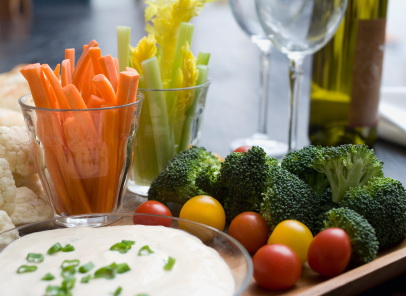When it comes to the task of pairing vegetables with wine, an award-winning sommelier and wine writer is up to the challenge.

“A lot of us are eating a lot more than meat these days, and even if you haven’t gone completely vegetarian, the move towards more healthy eating means there is a lot more greenery on our plates,” says Natalie MacLean.
But she does agree the match between the plate and the glass becomes more challenging when it comes to seeking veggie-friendly wines.
Full-bodied red wines should be avoided because they contain tannins, she explains. These are the natural substance from the stems, skins and seeds of grapes that give wine a furry feeling on the tongue like over-steeped tea or walnuts.
“This natural compound in wine is really harsh with green vegetables,” she explains. “Unlike a protein-packed juicy steak, vegetables have no protein. Tannin and protein work together and that is why a Cabernet Sauvignon or Shiraz goes well with a juicy steak or lamb.”
MacLean says that, in general, white wines do much better than reds with vegetables.
However, she cautions that in this case high-alcohol white should be shunned because its fruit clashes with the zesty flavors of the vegetables.
Her choices to accompany vegetables include crisp whites with good acidity, such as bone-dry or off-dry German Riesling or a Vino Verde from Portugal.
“The ultimate veggie wine for me is a chilled New Zealand Sauvignon Blanc,” says MacLean. “It’s like a salad in a glass.”
Salads have their own wine needs, she says. A creamy salad dressing will soften the perception of bitterness in the wine.
“With mayonnaise you can drink a rounder, richer white wine like Chardonnay because it is nice and buttery.”
For salads of mixed field greens, she opts for wines with a floral character.
“My favorite salad wine is lime-fresh Australian Riesling or a dry German Riesling.”
When partnering wines with salad ingredients, such as cheese, nuts, herbs, bacon bits and mushrooms, MacLean suggests light red wines such as Pinot Noir, Chinon or Bardolino.
If serving wine with potatoes, squash, corn or sweet potatoes, MacLean recommends an oaky buttery Chardonnay, because these are starchy vegetables with no acidity.
As we head into barbecue season, grilled vegetables with their deeper flavors and smoky nuances call for a fuller body on both reds and whites, “although you are still dealing with a tannin, no-protein issue,” she says.
Your mom told you to eat your veggies and she was right. We all need five to 10 servings of greens a day, according to Canada’s Food Guide to Healthy Eating, whether vegetarian or meat-eater. And those who give up meat don’t necessarily give up the fruit of the vine.
Bet your mom didn’t tell you which wines go best with a leafy salad, or other vegetarian dishes, though, did she?
Sommelier and wine writer Natalie MacLean of Ottawa comes to the rescue with her suggestions on pairing her favourite drink with vegetables.
Serving wines with vegetables
Here are some tips on pairing vegetables with wine:
Avoid wines such as Cabernet Sauvignon or Shiraz as they can overpower vegetables and their tannins will clash as well.
Choose instead soft, smooth-textured fruity ones like Pinot Noir, Gamay and Sangiovese.
Avoid high-alcohol whites; their fruit is in contrast with the zesty flavours of vegetables.
Wines with a floral character do well with simple field greens.
A richer rounder white goes well with salads tossed with a creamy salad dressing.
Reprinted with permission of the London Free Press









A wonderful little quote… ‘it’s like a salad in a glass’ perfect description Natalie.